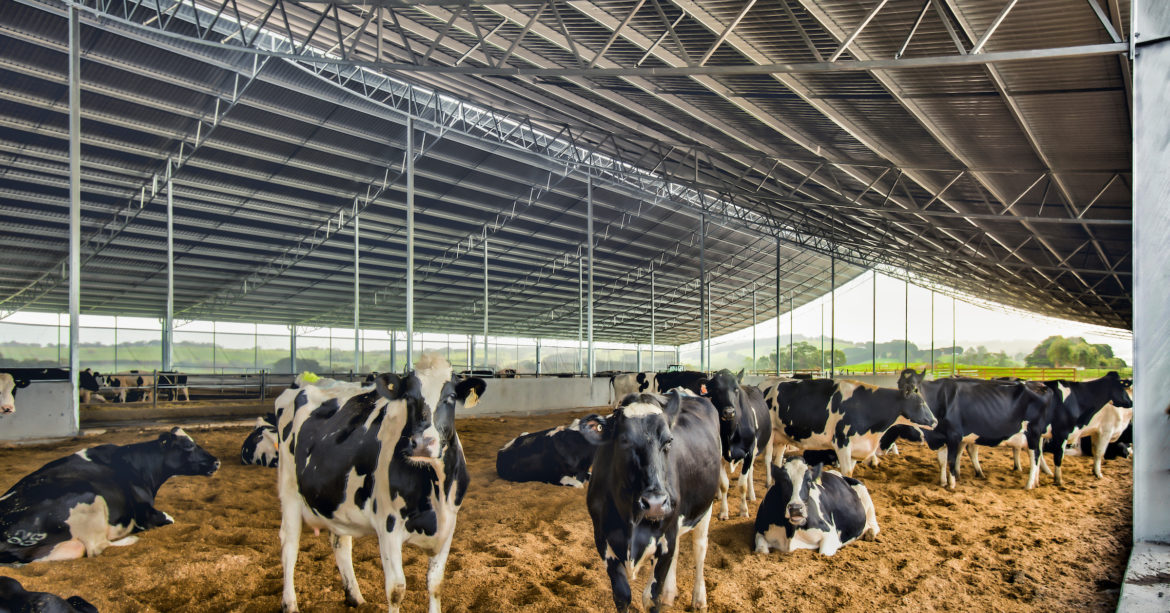Heat Stress in Dairy Cows
High temperature and humidity environments are uncomfortable for dairy cows and can lead to heat stress. This is important to dairy farmers because heat stress can lead to lower milk yields and reduced fertility, amongst other issues. During a hot summer, even night temperatures can be a problem.
Key points
- University of Melbourne research found that high temperature and humidity drastically reduced milk production as the cows grazed less and spent more time drinking
- Heat stress happens when heat production is high and the heat load of an animal is greater than its ability to lose heat
- Sheds and shade structures are increasingly being used to maintain ideal living conditions for dairy cows
Need a Quote?
Entegra Dairy Shed
RECOMMENDED ARTICLE
Managing cow heat stress to cut production losses – Entegra Signature Structures
This is borne out by research conducted by the universities of Melbourne and Ghana. The researchers studied lactating Holstein Friesian cows in Victoria, Australia. They found that high temperature and humidity drastically reduced milk production as the cows grazed less and spent more time drinking. This chart, produced by the University of Arkansas helps to show how this heat stress in cattle works.
What causes heat stress in dairy cows?
It’s clear that high heat and humidity levels can lead to heat stress in cows, but how does this happen?
 RECOMMENDED ARTICLE
RECOMMENDED ARTICLE
Heat stress happens when heat production is high and the heat load of an animal is greater than its ability to lose heat. In the case of cows; they feel hot sooner than people do. They are homoeothermic which means that they need to maintain a body temperature that is approximately 38.8°C plus or minus 0.5°C.
In order for this to happen, cows have a comfort zone, or thermoneutral zone, of -15°C to +25°C when it comes to ambient temperature. Once the +25°C (upper critical temperature) is reached, cows try to maintain their body temperature balance in two ways.
- Attempting to dissipate heat using methods such as panting or drooling.
- Limiting the production of heat by cutting back on activity and feeding less.
If these methods do not work, a cow starts to suffer from heat stress. This usually happens once the upper critical temperature level is breached.
It’s important to note that high-yielding cows always produce more body heat, no matter what the ambient temperature is. This means that they are more susceptible to heat stress. Bearing all of this in mind, it’s important that dairy farmers understand the signs of heat stress in cattle.
Signs of heat stress in dairy cows
High-yielding cows show more signs of heat stress because they produce more body heat. However, it’s possible for all dairy cows to exhibit symptoms, depending on the ambient temperature.
Moderate signs will usually begin to show when the temperature is between 80° and 90°F and humidity is from 50% to 90%. More severe signs of the effect of heat stress will usually develop when the temperature is 90° to 100°F and humidity levels are at 50% to 90%.
Visible signs of heat stress in dairy cattle include:
- Less activity.
- Increased respiration including panting.
- Trouble breathing.
- Excessive sweating.
- Excessive drooling.
- Reduced feed intake.
- Increased thirst and water consumption.
- Urinating more frequently.
- Increased levels of metritis.
- Reduced levels of insemination success.
- More mammary gland infections.
- Increased levels of laminitis.
- Premature calves.
- Convulsions.
Signs of heat stress in cattle that are not visible include;
- Lower ruminal pH.
- Slower digestion of food.
- Alteration to reproductive hormones.
- Increased levels of stress hormones in the blood.
- Activation of heat shock proteins.
- Often significant cell damage.
Given the serious nature of heat stress, dairy farmers need to watch for the signs. There are also actions that they can take to reduce heat stress and associated risks.
How to reduce heat stress in dairy cows
Dairy Australia provides some useful advice concerning the subject of heat stress in dairy cows. The major purpose of any such information is to reduce the risk of heat stress. There are a few main areas of advice that are especially significant.
Provide Sufficient Water
Providing lactating cows with the right amount of water is essential. Normally, an individual cow drinks around 100 litres of water each day. Troughs should never be allowed to run dry as cows drink on around four to six different occasions; often after milking.
Ensure feed is high quality
Food should be high in quality. It’s important for dairy farmers to realise that high fibre content in food can help to increase the heat load on a cow because it can lead to a raised heat of fermentation in the rumen.
Give enough shade
Research has shown how sheds have an important effect on a cow’s microclimate. With this in mind, shade should be provided in sheds where possible. It’s also important that shade is provided in paddocks, such as the shade from trees.
Maintain good handling
The way dairy cows are handled is vital to dealing with heat stress during periods of hot weather. The distance and speed of the journey to the dairy should be minimised. There should also be a strict limit to the amount of time that cows spend in areas where there is no shade.
Heat stress is a serious issue for dairy cows and for farmers. It can damage the health of cattle and reduce yields.
In order to reduce the chances of heat stress becoming a major issue, farmers need to be aware of the signs. They also need to ensure that dairy cattle have enough water and shade and that they are handled in the right way.
RECOMMENDED ARTICLES
Milking cows in the heat – Entegra Signature Structures
How Technology is Transforming Dairy Farms – Entegra Signature Structures
The Story of Australia’s First Dairy Cows – Entegra Signature Structures
Managing cow heat stress to cut production losses – Entegra Signature Structures
https://www.nadis.org.uk/disease-a-z/cattle/managing-heat-stress-in-dairy-cows/



 RECOMMENDED ARTICLE
RECOMMENDED ARTICLE